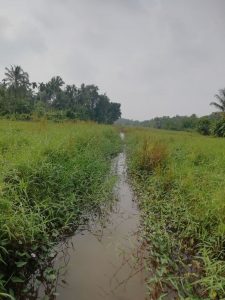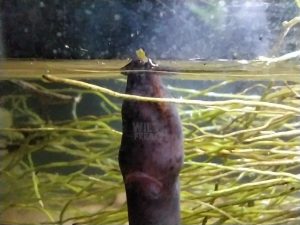
This group is widely distributed in lowland fresh and occasionally brackish waters in the tropics and subtropics. Although some species live in clear flowing streams, most inhabit sluggish or standing waters,
often with low oxygen content, commonly in dense vegetation or other
cover, and are frequently burrowing or amphibious.
Many if not all species are capable of aerial respiration and can survive
periodic drying of their environment.
grown-up swamp eels have for all intents and purposes no fins, the hatchlings have enormous pectoral fins which they use to fan water over their bodies, in this manner guaranteeing gas trade before their grown-up breathing contraption creates. When about a fortnight old they shed these fins and expect the grown-up structure. Most types of swamp eel are bisexual, beginning life as females and later changing to male, however, a few eels start life as males and don’t change sex.
Sri Lanka is home for two species of Swamp Eels.
Ophichthys desilvai

Previously known as Monopterus desilvai, classified under the genus Monopterus, recently classified under the genus Ophichthys.
This species was first introduced in 1998 by renowned Zoologist Sampath de Alwis Goonethilake. He has named this swamp eel as Monopterus desilvai in honour Philip Hewa Don Hemasiri de Silva, a former director and botanist at the National Museum. It was first encountered by a group of school children in 1976 in a paddy field environment in Marawila on the coast of the North-Western Province. But Mr Gunathilaka came across this type of animal on February 10, 1993, from a friend of his, Ananda Abeydheera from Bandaragama. That is why Mr Gunathilaka researched this animal and introduced it to the world as a new species in 1998 by introducing Monopterus desilvai. According to the research carried out, these animals have been reported in the flood-prone areas of the Bolgoda Lake in the Western Province, in the low lying areas of Bandaragama, in the waterways associated with vegetable plantations and in the Marawila area.

This species has relatively smaller eyes covered by a skin, connected gill opening. the head is clearly visible from the rest of the body. part of the snout and upper jaw overhangs, the ventrally positioned mouth. Body, eel-like and robust. The underside of an animal or plant; abdominal part of the tail partly scaled (embedded scales), but these scales are not clearly visible. Dorsal and anal fold continuous without rays and greatly reduced. Pectorals and pelvic fins absent. The caudal tip is bluntly pointed. The gill openings extend under the neck to join up below the throat and nearly crescentic in shape. the gill opening is internally attached to the isthmus.
Researchers say they breathe in atmospheric oxygen. Atmospheric oxygen helps their skin retain moisture. However, even in a low-oxygen environment, they have adapted to life, These species come to the surface of the water to breathe and wait a minute or two before hiding again. This freshwater fish has a special pair of lung-like specialized sac for this purpose. Body colour is light-brown in colour with dark tiny spots throughout the body. The ventral side is lighter in colour.

This Eel lives in canals with a dark muddy substrate, within the vegetable fields. They were Normally shy of light and usually hide among the vegetation, They prefer mud as substrates.
Researchers believe the species may be found in floodplains, swamps, paddy fields and vegetable gardens off the coast. Although suitable habitats for them are still found in the floodplains of flood-prone areas of Sri Lanka, such places are rapidly being destroyed due to human activities. Today they are losing their habitat due to swampland reclamation and extensive use for cultivation. Ophichthys desilvai even listed in the IUCN Red List of Threatened Species as an Endangered species.
Monopterus desilvai breathing atmospheric air
Defecating
References:
Britz R, Sudasinghe H, Sykes D, Ranasinghe RHT (2020) Ophichthys desilvai, a poorly known
synbranchid eel from Sri Lanka (Teleostei: Synbranchidae). Ichthyological Exploration of
Freshwaters 1139: 1–16
Goonatilake, W. L. D. P. T. S. de A. 2000. Rediscovery of endemic brown blind swamp-eel, Monopterus desilvai Bailey & Gans, 1998; family: Synbranchidae, after twenty years from Sri Lanka. Loris, 22: 42-44.






